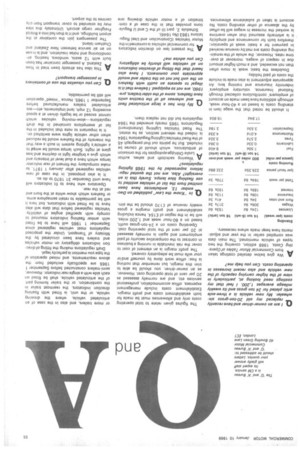a I am an owner-driver and have recently
Page 57

If you've noticed an error in this article please click here to report it so we can fix it.
replaced my old 20-ton-gross sixwheeler. My new vehicle is a three-axle artic plated for 24 ton gross and its weekly mileage averages 1,200. I feel that my castings need looking at, paiticularly in view of the higher carrying capacity of the new vehicle and also recent increases in operating costs. Can you help me?
AWe give below detailed costings taken
from Commercial Motor Tables of Operating Costs, 1968 edition, covering the two types of vehicle mentioned. The main data was compiled earlier in the year and adjustments have been made where necessary.
It should be noted that the wage item in standing costs is based on a 40-hour week, although additions have been made on account of employers' contributions collected through National Insurance, voluntary employers' indemnity insurance and training levy. An appropriate adjustment is also made to include the costs of paid holiday.
Doubtless the basic week is more often than not exceeded, and a much higher amount due in respect of wages, moreover at overtime rates. However, the whole of the remaining standing costs are met by revenue received in payment for a basic week of operation; therefore both for convenience and simplicity it is arbitrarily assumed that when overtime is worked the increase in wages will be offset by the absence of other standing costs. No account is taken of subsistence allowances. The figures given relate to total operating costs only and allowances must be made for both establishment costs and profit margin. Establishment costs include management expenses, office accommodation, professional services etc. and are normally assessed as 20 per cent of total operating cost. However, as an owner-driver, you should be able to trim this margin, but remember that nothing is free: office work done by yourself and/or your wife must be adequately covered.
The profit margin is an element of cost to cover the risk inevitable in running a business in contrast to the comparative security of paid employment and again is normally assessed at 20 per cent of the total operating cost.
Operating costs on a 24-ton-gross outfit, based on a 60-hour week and 1,200 miles. will be in the region of £154, hence including establishment and profit margins a gross weekly revenue of £170 should be the aim.
QIn "Know the Law" published on Dec
ember 13, ambulances have been omitted from the list of vehicles entitled to use flashing blue lamps. Surely this is an oversight? Also, are not the quoted regulations superseded by the 1965 lighting regulations?
AWearing sackcloth and ashes, author Leslie Oldridgeapologizes for the omission of ambulances, which should of course be included. But he points out that paragraph 45 of the Road Vehicles Lighting Regulations 1964 is indeed the relevant section, as he stated. The Road Vehicles Lighting (Amendment) Regulations 1965 merely amended the 1964 regulations but did not replace them.
QMy firm has a large articulated fleet and whereas all of the tractive units have flashers, some of the older trailers, pre1960, are not so equipped. believe that it/s illegal to operate an outfit with flashers on the unit but not on the trailer and would appreciate your comments. I have also heard that the fitting of direction indicators on all vehicles will shortly be obligatory. Can you advise me?
AThe present law on direction indicators for commercial vehicles is contained in the Motor Vehicles (Construction and Use) Regulations 1963 (No 1646).
Schedule 2. part III of the C and U Regulations provides that in the case of a combination of a motor vehicle drawing one
or more trailers, and also in the case of an articulated vehicle, where the drawing vehicle, or the unit, is fitted with flashing direction indicators, the rearmost trailer in the combination, or the trailer forming part of the articulated vehicle, shall be fitted on each side with a single rear indicator. However, semi-trailers constructed before September 1 1965 are specifically excluded from the above requirements, and mixed operation of the type you mention is perfectly legal.
Draft regulations making the fitting of direction indicators obligatory on motor vehicles and trailers have been circulated by the Ministry of Transport. Under the proposed regulations most vehicles registered since September 1 1965 will have to be fitted with amber flashing indicators mounted to comply with specified angles of visibility. Vehicles registered before that date will also have to be fitted with indicators, but here it will be permissible to retain semaphore arms, or flashers which show white at the front and red at the rear.
Operators who have to fit indicators will have until December 31 1970 to do so.
It is also proposed, in the case of new vehicles registered after January 1 1971, to make compulsory the fitment of rear indicator lamps which have a dual level of intensity and which give a brighter light in daytime and less glare at night. Such lamps would be wired to a vehicle's lighting system in such a way that the intensity of the flashers would be reduced when other vehicle lights were switched on.
It is important to note that included in the list of exemptions contained in the draft regulations—slow-moving vehicles which cannot exceed or be legally driven at a speed exceeding 12 mph, land implements, etc—are articulated trailers manufactured before September 1 1965. Hence "mixed" operation will still be permissible.
QCan you visualize the use of containers in passenger transport?
AThis idea has already been tried in New Zealand. A passenger container has been built with 12 seats, windows, heating, airconditioning and noise insulation, and is in use on an air service between New Zealand and Chatham Island.
The passengers join the container at the airport buildings, and it is then fed into a Bristol Freighter cargo aircraft. Ultimately this idea may be extended to cover transport from city centres to the airport.








































































































